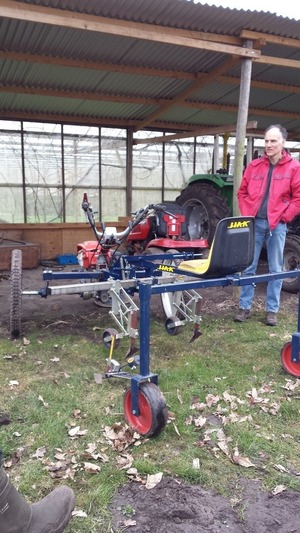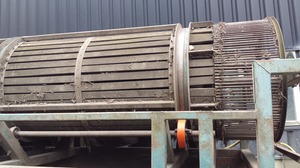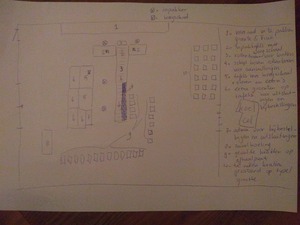Case study 23: The Netherlands: Multi-cropping for vegetable production in short supply chains
Cluster 5: Diversification of vegetable cropping systems
Many small and medium-size organic farms in The Netherlands grow a diverse set of crops and sell to a wide variety of supply chains, but there is pressure to reduce the number of crops to manage workload, mechanization, and marketing among other things. A group of organic farmers that are proud of their diverse product range and keen to maintain this diversity teamed up and jointly looked for solutions.
What were the main problems underlying the emergence of the case study?
Crop diversification is a challenge for all organic farms even if it should be a principle in organic farming given its potential role in decreasing pest pressure and managing soil fertility.
For many years, medium-sized and larger organic arable farmers have organised themselves in regional networks for learning and marketing. Smaller organic farms have a network, consisting of one national association. The networks tend to focus on (single) cropping techniques and the association lacks funds to organise knowledge exchange for their members. There is a shared sense among medium and small farms of problems emerging regarding diversified production systems and the threats to diversification. Bionext, the umbrella organisation for organic production in the Netherlands, is in the position to address both groups and to help facilitate the identification of ways forward.
How was the problem addressed and which actors were involved?
Bionext is the case study leader and is supported by Wageningen University and Research (WUR) as the case study monitor. At the start of DiverIMPACTS, a core group of six organic mediumsized and smaller vegetable growers that grow a wide diversity of crops was created. Together, they identified the main challenge to be addressed and two main options to be elaborated. The main challenge was to reduce the workload while maintaining crop diversity. One option was to reduce the workload by reducing weeding hours. The second one was to scrutinize the handling processes on the farm, including harvesting, and see what could be optimized. As a part of the second option, the marketing and supply chains would also be taken into account. The core group held regular meetings at each of the farms. Part of each meeting was a farm tour during which the participants discussed the management of the particular farm and suggested improvements. Another part of the meetings were contributions from external experts or researchers to review the knowledge available on topics of relevance to the main challenge. The findings from this process were shared with a wider audience through farmer magazines and by connecting with grower organizations. In addition to the on-farm exchanges, the core group visited a mechanization fair and a web shop to enrich their ideas.
Solution investigated
When looking at reducing weed control, the following solutions were investigated:
- Weeding robots: Are there weeding robots that are (almost) ready to use that would reduce weeding labour? The farmers learned in 2019, by speaking with a robot developer and inviting a researcher on mechanisation of weed control that, for the moment and probably the coming years, such a product is not available on the market for arable farms with diverse crops.
- Increasing the efficacy of already available weeding equipment such as the fingerweeder: this can have many benefits. The idea of organizing a competition among farm teams using their own favourite tools was considered and pursued for a while but it was given up due to the Corona pandemic and lack of sponsors.
- Smart planting and weeding strategies: sowing seeds or buying seedlings and exact time of weeding are factors that play a role in reducing overall weeding workload.
- Rod weeder: Multiannual weeds with long roots can be removed with the rod weeder (See below: De Rod weeder). Despite looking rather simple, it works.
When looking at on-farm logistics, the following solutions were investigated:
- Peer-to-peer review of on-farm operations: The group proposed and developed the “give a day, get a day” system where a farmer invests a day working on another farm and receives a day’s work from the other farmer. The mutual visits coincided with peak activity moments, e.g. preparation of orders or harvesting. At the end of the day the farmers discussed their observations on farm organization. During the next group meeting lessons were shared in the network.
- In on-line meetings during the covid-crisis farmers presented the routing of produce on their farms to each other based on self-drawn maps. After a short presentation by a farmer and a round of questions, a ‘gossip session’ was held where the other farmers discussed the set-up and issues presented by the farmer. At the end of the session, the farmer would share his insights from the meeting. This resulted in various adjustments, such as in the location or upgrades of machines.
Some of the lessons learned include:
- There is a range of weeding tools for small farms. There are more options for mart, manual and light mechanical weed control than is generally known.
- Manual harvesting vs mechanical harvesting needs careful consideration in terms of time investment vs quality. With a carrot harvester you can quickly harvest carrots. But if you want to sell them in a box scheme in several periods, gradual manual harvesting gives better quality carrots for the box schemes (even though it is a tough job).
- A critical look at on-farm logistics is worthwhile, but it is not easy to find advisors with good expertise. And the situation is very farm specific. Peer-to-peer review has proven to be a practical way to increase joint knowledge.
- When manually harvesting carrots, it is hard to heave the smaller crates high to collect the carrots in the larger (1 m3) storage boxes. There appeared to be storage boxes where one side could be partly removed, facilitating the work. Unfortunately, these are not being made anymore.
- Small sorting belts can be really helpful when sorting produce such as beets or carrots.
- Strawberry picking is physically demanding. An idea is to have a rail fitted with a little cart.
- Pumpkins and zucchinis: should producers buy seedlings or sow them themselves? It can take up to 2 days per hectare to sow the plants in little pots. It may be worthwhile to explore alternatives. It is e.g. also possible to buy the pots with the seeds in them and grow the seedlings yourself. This method is cheaper than buying the plants and saves time.
- Marketing channels: it became clear that online shops are not an easy marketing channel for the farmers. A conversation with an organic online shop owner showed that it is a very demanding task. Existing local online shops can be a good marketing channel for smaller quantities.
- Size matters: the size of your (beetroot/carrot) washer should be fitting to the portion you need to clean. If you fill a 1000 kg washer with 500 kg of product the products will not get cleaned properly, as they usually get cleaned by the effect of the products rubbing against each other. But if you wash 1000 kg for a 500 kg delivery you have a storage problem.
- You need room to manoeuvre when you wash and store many different crops. But since you do not use the washing room continuously, desks, chests, and other space consuming things get in the way. It is worthwhile to check the lay-out and routing of your washing room, especially if you have been using it for a number of years.
- Good light in the storage room helps you to find the products quicker. One farmer decreased movement around his cold storage a lot by installing a second door.
Expected outcome
The goal of the case study is to share progress and possible solutions and to give the farmers the tools to better manage their workload.
The vegetable growers will be able to better maintain a high number of crops through improved marketing and/or farm management.
Case study legacy
The legacy consists of two elements. The first is the way we have been working and the issues we discussed. Discussing layout of storage rooms and work efficiency goes beyond the topics farmers discuss with farm advisors. The technique of using peer-to-peer learning was seen as stimulating and emancipating. This topic and the developed working formats were suggested as a mini project for an organic horticultural growers association. The organization took it up in the 2021 season with facilitated study group meetings, and reactions in 2022 were positive. The growers association will continue with the formats in the 2022 season. This progress has not been hampered by Covid-19. Some group meetings were done digitally. The second element that may be called a legacy is the idea that we also need to stimulate peer-to-peer learning about using weeding machinery and introducing a competitive element. This was not executed as part of the project. The main reason for this was covid-19.
Further information
Links
Videos
- youtube.com: The rod weeder (Dutch)
- youtube.com: Film on how to fine-tune a fingerweeder and tined weeder (Dutch)
Publications
- zenodo.org: A participatory approach to improving farm logistics
- zenodo.org: Teeltdiversiteit: wat werkt? Tuinders leren van tuinders
- zenodo.org: Greenpaper Diversiteit in teelt
- zenodo.org: Bladgewassen handig oogsten, wassen, wegen en verpakken
- zenodo.org: De Stroom: Pakkettenbedrijf met visie
Case study team
- Marian Blom, Bionext, case study leader
- Walter Rossing, WUR, case study monitor




 tap and then scroll down to the Add to Home Screen command.
tap and then scroll down to the Add to Home Screen command.